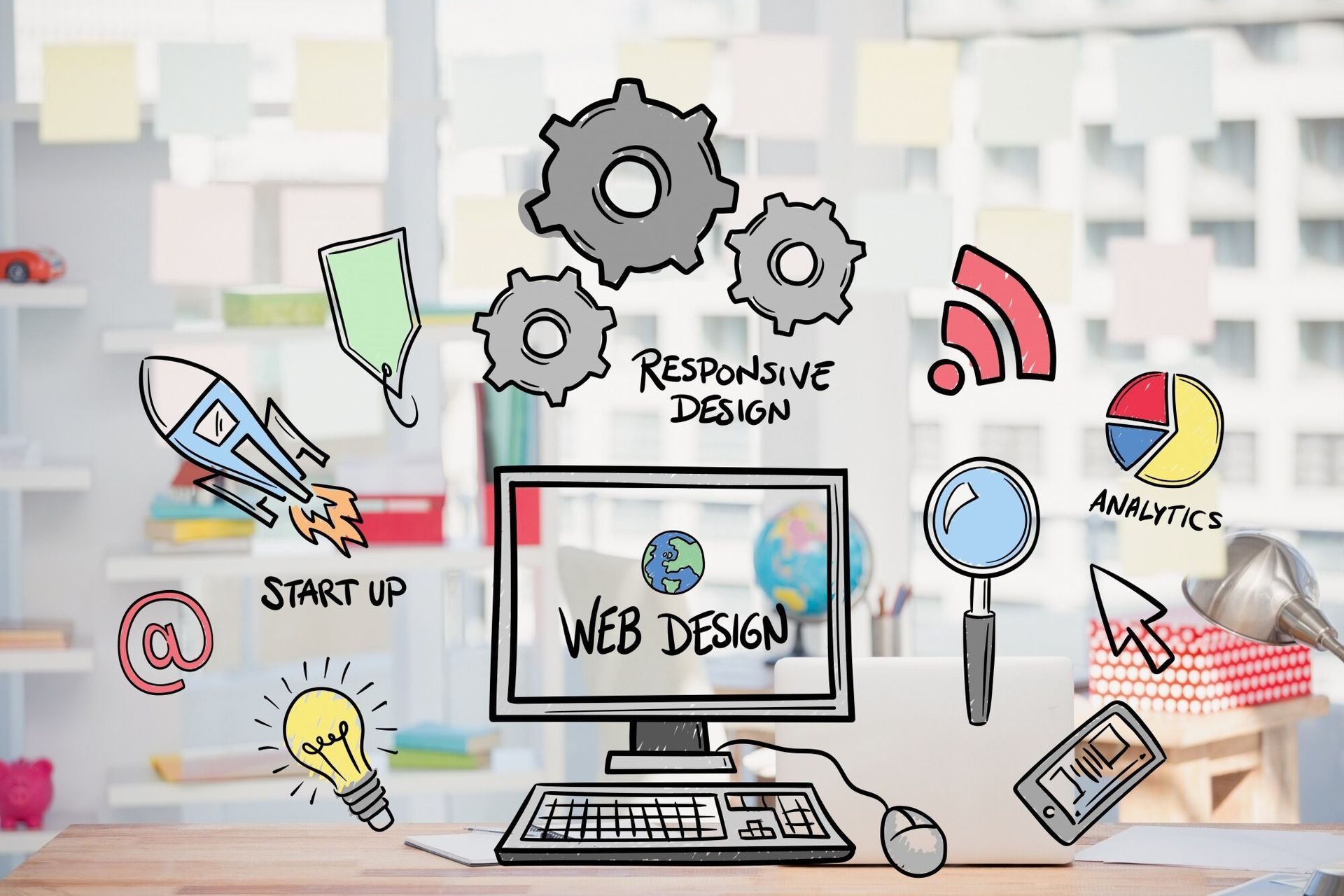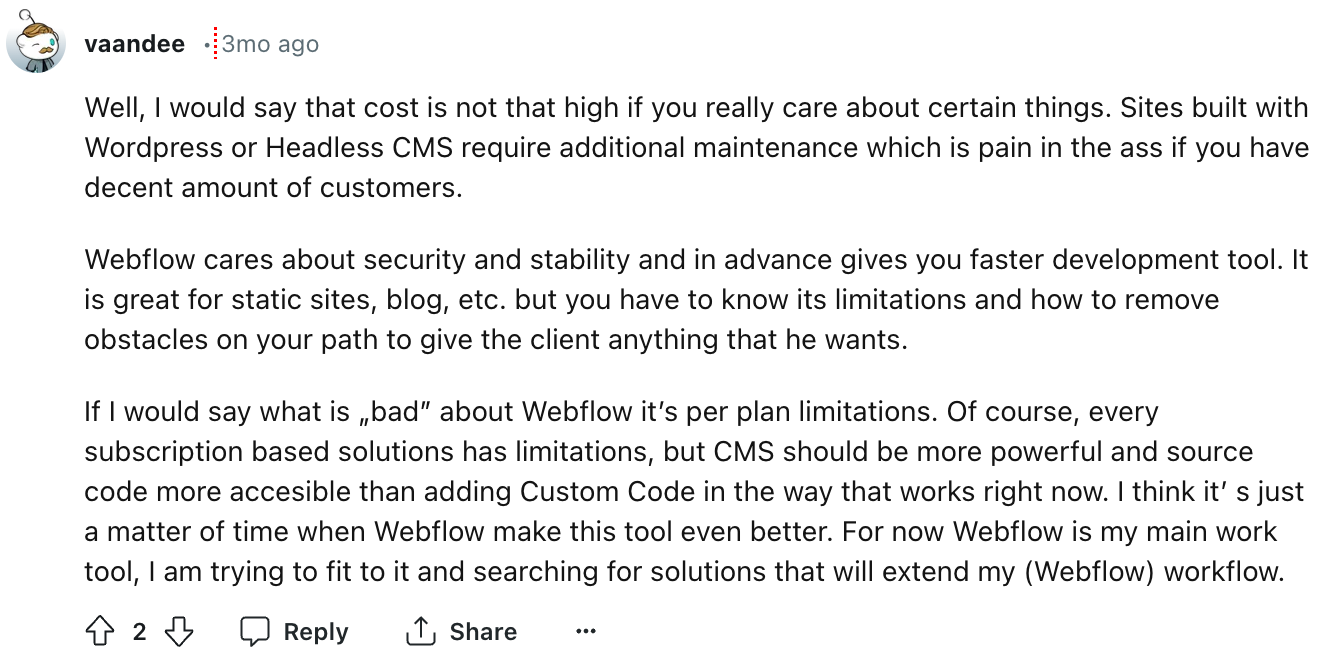Dale McManus mentions that WordPress simplifies website creation and management for all skill levels. Its extensive library of themes and plugins crafts unique and functional websites effortlessly. With its intuitive interface and automation features, WordPress streamlines the web development process. It earns high praise from beginners and seasoned professionals alike.
Snapps courses are now available
Webflow addresses your essential website's needs more than WordPress. Attracting over 3.5 million users, Webflow is more user-friendly. It also has good design, flexible, scalable and secure. It is an ideal solution if you seek website design automation with no coding knowledge. As a headless CMS, Webflow allows you to be flexible in managing your content. It assures a better online presence for businesses. Meanwhile, WordPress is slightly difficult to learn for beginners. The plugin ecosystem takes time to learn, but it is functional and SEO-optimized.
The wrong website builder can have terrible effects on your online presence. 38% of visitors will stop engaging if the content or layout is unattractive. A poorly designed site is on how poor your builder is. Your website needs to choose the builder with the most essential needs. These are the top two platforms that can boost user engagement and drive conversions. Either can protect you from any website risk, cyber threats, and boost your SERPs. By specifying your ideal platform, you can grow your business in the digital market. Here's an overview of what we will be discussing later on:
| Website Feature | Preferred Platform |
|---|---|
| Ease of Use | Webflow |
| Website Functionality | WordPress |
| Design Flexibility | Webflow |
| SEO Features | WordPress |
| Scalability | Webflow |
| Performance & Security | Webflow |
| Customer Support | Webflow |
| Third-Party Integrations | Webflow |
| Pricing Plan | WordPress |
| Content Management System (CMS) | WordPress |

Essential Priorities
1. Webflow: Ease of Use
Webflow is easier to use than WordPress. The drag-and-drop editor has attracted 3.5 million users, drawing them to the platform. You can create websites without coding. You can customize your website anytime. It offers a smooth workflow for all designers and developers. Some of its features include:
- Visual Editor: This enables users to see their changes in real-time. It makes the design process more interactive and efficient.
- Custom Interactions: Add custom interactions and animations without writing code.
- Responsive Design: Websites respond to Webflow.
The only issue we have: it takes time to learn the editor, especially if you’re a beginner. Take advantage of the tutorials and community forums.

As for WordPress, it relies on plug-ins. This sometimes leads to performance issues. You’ll have to manage them on your website. Others say that the WordPress ecosystem is so complex. You’ll have to navigate the settings and configurations. But, WordPress offers themes and templates that can still make it user-friendly. There is a lot to choose from so you can customize websites.
2. WordPress: Website Functionality
WordPress has better website functionality than Webflow. Although the learning curve may be intimidating, it is workable. We mentioned earlier how plug-ins are hard to learn, but it’s worth the shot. Through plug-ins, you can expand what your site is capable of. This is from SEO optimization and ecommerce integration too. The themes can improve your site’s appearance with minimal effort.
So if you’re a blogger or entrepreneur, WordPress can help your business grow with these features. Bricks Builder is another WordPress integration. It enhances code quality and is perfect for developers.

Webflow also has responsive layouts and interactive elements. They can also add animations as well. But, the price is not good for those on a budget. You’ll have to spend more to have functional features.
3. Webflow: Design Flexibility
Webflow offers its users more design flexibility than WordPress. You create visually stunning websites and have full control over your site’s design. Webflow’s editor allows you to put the elements you want for your site without the coding. Also, the builder’s templates can adapt to any screen size. This enhances user experience.

If your budget’s limited, you can settle with WordPress. WordPress also offers a lot of themes and page builders like Elementor. For customization, the site’s limited. Also, be cautious about the plug-ins. Using too many plugins can affect performance.
4. WordPress: SEO Features
Stick with WordPress rather than Webflow if SEO is your priority. WordPress offers better SEO capabilities. It may take time to learn, but its interface is easier for SEO plugins. One popular SEO feature is YOAST SEO. There are over 5 million activations because it optimizes individual pages and posts. The analysis tool of YOAST SEO also provides suggestions so you can improve SEO. A warning–don’t rely so much on the plug-ins. This avoids technical debt and security issues.

Webflow has built-in SEO features. They focus on providing user-friendly experiences for their users. But, do not use this web builder if you are working on large-scale projects like ecommerce. It does not have much advanced SEO features, so products can be hard to manage. Webflow is only perfect for personal blogs, portfolios, and anything light.
5. Webflow: Scalability
Webflow stands out for its scalability over WordPress. Webflow has a cloud-hosted platform. It’s more efficient for handling traffic. It does not need you to optimize it by hand both when your traffic increases or decreases. Webflow users in the US experience 25.28% of traffic on their websites. Webflow makes sure that websites are seamless for every user and whatever device. Also, the platform’s CMS allows you to create good content structures. This is a good focus on scalability.

Sam Harrison mentions in his Webflow review that this CMS has a user-friendly interface. Webflow also has robust content management capabilities that are easily customizable.
While WordPress can scale effectively, you need to manage the performance by hand. You’ll have to keep monitoring and making adjustments to optimize your websites. Also, this increases your workload. What you can do is to practice coding. This minimizes the challenges when you scale your website.
6. Webflow: Performance and Security
Webflow provides better performance and security than WordPress. If you’re looking for something hassle-free, stick with Webflow. It simplifies website maintenance through automation. Being a drag-and-drop builder, it lets you create designs and content effortlessly. Some of its features include:
- Automated Maintenance: Maintains updates and backups. You don’t have to do it manually.
- HTTPS and SSL: These two codes secures browsing. It communicates that your website does not cause any harm and your web server is safe.
- Regular Backups: Webflow automatically backs up your website data. The platform prevents you from any data loss.

Webflow vs WordPress: High-Value Considerations
Aside from the essentials, also consider its customer support, third-party integrations, pricing, and Content Management System (CMS). These factors create a better-quality website. We’ve prepared a table so you can assess your needs.
Webflow vs WordPress: Customer Support
| Webflow | WordPress |
|---|---|
| Offers dedicated customer support | Support is on hosting providers and plugin developers |
| Offers live chat and email support | Relies on community forums and third-party support |
| Quick help via chat, email, and extensive docs | Mixed opinions on effectiveness of support |
The ideal platform: Webflow has good customer support and is more than WordPress. They have live chat and email help, providing a smoother user experience. WordPress support relies on community forums. This can cause mixed opinions to users.
Webflow vs WordPress: Third-Party Integrations
| Webflow | WordPress |
|---|---|
| Allows for custom integrations without relying too much on third-party plugins. This allows smoother functionality and performance. | Supports an ecosystem of plugins to integrate with third-party services. |
| No third-party plugins and results in better performance. Not reliant on third-party plugins, resulting in better performance. | 40,000+ plugins available in the WordPress plugin repository. |
The ideal platform: Webflow allows for custom integrations. They don’t rely on third-party plugins, so it functions. Webflow also offers greater performance than WordPress. Using too many plugins hampers the performance of WordPress.
Webflow vs WordPress: Pricing Plan
| Webflow’s Pricing Plan | What’s in it? |
|---|---|
| Starter (Free) | An entry level site, 1GB bandwidth, 1k visitors |
| Basic ($14) | Custom domain, 50GB bandwidth, 250k visitors |
| CMS ($23) | 2 content editors, site search, 200GB bandwidth, 250k visitors |
| Business ($39) | 10 content editors, site search, 400GB bandwidth, 300k visitors |
| WordPress' Pricing Plan | What’s in it? |
|---|---|
| Free | Free themes, 1GB Storage Space, SSL Certificate |
| Personal ($4) | Free domain for one year, collect payments, email support |
| Premium ($8) | Google Analytics, ad revenue, premium themes |
| Business ($25) | 50 thousand plugins, site backups, one-click restore |
| Commerce ($45) | E-commerce marketing tools, premium design; integrations with top shipping carriers |
The ideal platform: WordPress has better pricing for a website builder. For starters, WordPress gives out free themes and an SSL certificate. This certificate sends a good impression that you are a credible business. It comes with affordable hosting options and free plugins as well. Webflow has higher prices. Its CMS costs three times higher than WordPress because of its automated maintenance tasks.
WordPress vs Webflow: Content Management System (CMS)
| Webflow | WordPress |
|---|---|
| More focused on the design to manage content | You can have full ownership and control over the website |
| Has an appealing interface to edit content. | Allows unlimited customization and flexibility. |
The ideal platform: WordPress is the better CMS platform. Whether a beginner or an expert, this has a dashboard that adds content and change design. There’s a vast community of users who can help you if you run into problems. Webflow lacks CMS features, so it's not advisable for this aspect.
Webflow vs WordPress: Best for your Small Business
As a small business owner, a website builder can help you establish a strong digital presence. Let’s compare Webflow and WordPress. See what features suit your specific business needs.
1. Ecommerce Services
- Ideal Platform: Webflow
- Ecommerce Features on Webflow:
- Visual website designs for an aesthetic website.
- Interactive elements for immersive online stores.
- Design flexibility and responsive layouts for businesses to stand out.
2. Educational Institutes
- Ideal Platform: WordPress
- Educational Institute Features on WordPress:
- Good plugin ecosystem like LearnDash Management. It can:
- Manage online courses
- Track student progress
- Provide learning experience
3. Restaurants
- Ideal Platform: Webflow
- Restaurant Features on Webflow:
- Design-centric approach and custom interactions
- Seamless integration of menu displays and reservation systems
4. Travel Agencies
- Ideal Platform: WordPress
- Travel Agency Features on WordPress:
- WP Travel plugin provides functionality. It can:
- Manage bookings
- Showcase destinations
- Provide interactive itineraries
5. Professional Services
- Ideal Platform: WordPress
- Professional Service Features on WordPress:
- Extensive plugins like WPForms for appointment scheduling
- YOAST SEO improves online visibility.
- Professional service tools to manage your business.
6. Home Services
- Ideal Platform: Webflow
- Home Service Features on Webflow:
- Design flexibility and visual appeal is an attractive essential needed for home services
- Portfolio building elements
7. Real Estate
- Platform Preference: WordPress
- Real Estate Features on WordPress:
- Real Estate Manager plugin for property listings and website functionality.
- Divi for customizable layout
Snapps.ai: An Emerging Platform for Your Website Needs
Snapps.ai isn't another website builder. It empowers small businesses to achieve their goals. Snapps.ai stands out because you can create quickly but in high quality. Also, its interface and tools streamline your website building from scratch to finish. It offers a good hosting infrastructure. Your website to load fast, be secure, and remain reliable. You can say goodbye to downtown because Snapps.ai keeps your site running 24/7.
So far, over 100 companies worldwide trust Snapps.ai to power their online presence. From startups to Fortune 500 enterprises, expect detailed ranking reports and stunning visuals. Your technical SEO issues can also get instant results with its tools. Snapps.ai also uses AI to simplify tasks and elevate your creativity. Experience scaling your website with Snapps.ai without breaking your bank!
Recent Articles
Our Support Heroes Are Here For You
Don’t waste time on tedious manual tasks. Let Automation do it for you. Simplify workflows, reduce errors, and save time for solving more important problems.



